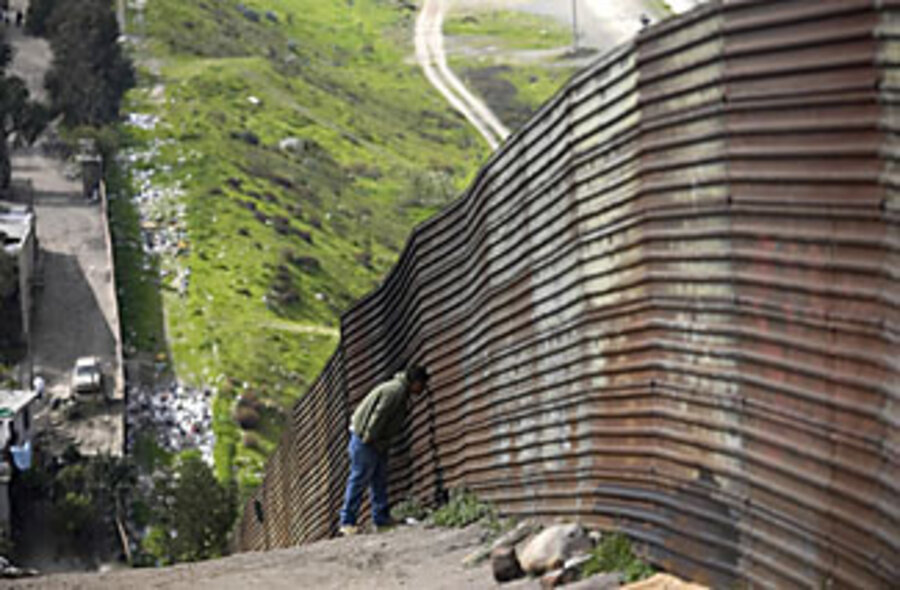With fewer jobs, fewer illegal immigrants
Loading...
The economic downturn – along with more aggressive enforcement – is reducing the flow of illegal immigrants to the United States.
Not only are fewer people – mostly Hispanics – slipping into the United States, they're getting fewer jobs. New data shows that Latino participation in the labor force – normally among the highest – has dropped along with a decline in new arrivals.
"The picture has definitely changed," says Randy Capps, a demographer at the Migration Policy Institute in Washington, though he cautions that it's too early to say whether the changes are permanent. "Unauthorized Hispanic immigrants are fairly responsive to job markets." [Editor's note: The original version misspelled Mr. Capps' name.]
Tougher enforcement and the construction of a new border fence may also be playing a role. The number of illegal aliens removed or returned home this year rose 20 percent compared with a year ago, according to a Department of Homeland Security statement. There was also a 27 percent increase in arrests made while raiding workplaces by the US Immigration and Customs.
The Border Patrol, which added 6,000 agents since 2006, has seen a steady decline in the number of people it has caught trying to cross the border.
Exactly how far-reaching the current shifts in the Latino immigrant population are is unclear, and may turn on the extent of the recession and the immigration policies of the new administration.
Downturn hits Latinos hard
A recent report by the Pew Hispanic Center, a nonpartisan research group in Washington, found that the proportion of Latino immigrants employed or seeking work in the US fell for the first time since 2003. It declined from 72.4 percent in the last quarter of 2007 to 71.3 percent in the last quarter of 2008.
The drop is "small but significant," says the report's author, Rakesh Kochhar. As a percentage, more Hispanic immigrants are active in the labor force than other Americans.
The report also found that the unemployment rate for all Latinos was 7.9 percent in the third quarter of 2008, compared with 5.7 percent during last year's third quarter. The unemployment rate for the total US workforce is 6.1 percent.
It's not clear whether immigrant workers who have dropped out of the labor force are returning home or have just temporarily given up looking for jobs.
The decline in labor force participation is strongest among Latinos who arrived since 2000, according to Pew. Mexico's central bank reported in early 2008 that remittances had flatlined at about $24 billion after several years of large increases.
On the other hand, the number of passengers flying from the US to Mexico fell 4 percent in the past few years, according to the International Air Transport Association. Carlos Rico, Mexico's undersecretary for North American affairs, told the Associated Press last month that applications by emigrants to move their possessions back across the border haven't notably increased.
A long-term shift?
For many years now, the number of Hispanic workers entering the US has been growing at a remarkable pace, dramatically shifting the country's cultural makeup. In the past two years, that pace has slowed.
It's the inflow of undocumented workers that is falling, as legal immigration remains steady, says Mr. Capps, the Washington demographer. A Pew report released earlier this year found that the number of illegal immigrants arriving in the US had dropped to below that of legal arrivals, reversing a decade-long trend.
The report also found that illegal immigration from Mexico has leveled off since last year.
Latinos are increasingly exploring destinations that don't require treacherous desert journeys, says Patricia Mendez, a Honduran immigrant who came to the US five years ago and who heads Centro Presente, a Latino immigrant advocacy group outside Boston. Her brother, she says, recently emigrated to Spain, one of the most popular recent choices.
"Foreign born Hispanic workers are in a state of transition," Mr. Kochhar says. "Are we now going to see a drop in the population itself?"
At the very least, a long downturn could mean that the shift away from illegal immigration toward visa holders gains momentum.
If the trends continue, they could even alter the distribution of Latino immigrant communities in the US. A slowdown in arrivals could erode communities with more fragile, less-developed networks, says Irene Bloemraad, a sociologist at the University of California in Berkeley.
And those who do come may increasingly follow jobs to far-flung, recession-resistant agricultural areas like the upper Midwest, Capps says.
For now, those possibilities remain speculation – immigration policy reform led by the Obama administration, for instance, could change trends.
But the longer the downturn lasts and the more severe it is, the more uncertainty colors the future of Latino immigrants. "As far as I know, nobody knows where the light is at the end of this tunnel," says Kochhar.





